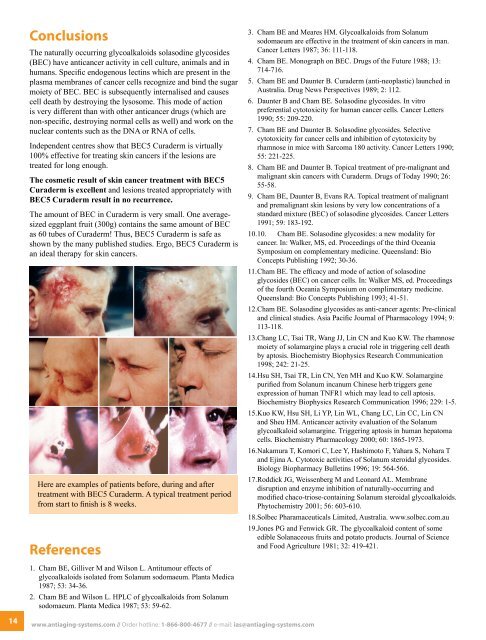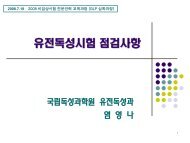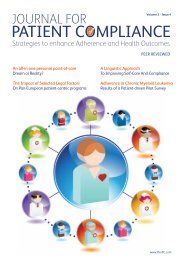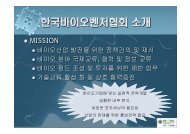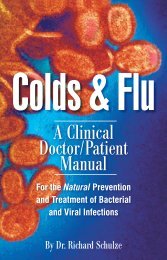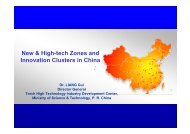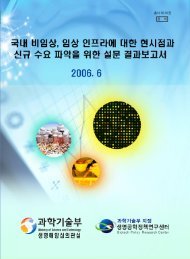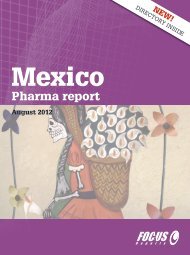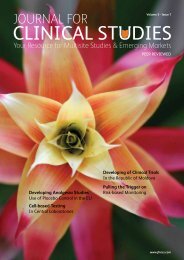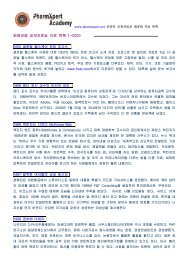Nanogen - PharmXpert Academy
Nanogen - PharmXpert Academy
Nanogen - PharmXpert Academy
Create successful ePaper yourself
Turn your PDF publications into a flip-book with our unique Google optimized e-Paper software.
Conclusions<br />
The naturally occurring glycoalkaloids solasodine glycosides<br />
(BEC) have anticancer activity in cell culture, animals and in<br />
humans. Specific endogenous lectins which are present in the<br />
plasma membranes of cancer cells recognize and bind the sugar<br />
moiety of BEC. BEC is subsequently internalised and causes<br />
cell death by destroying the lysosome. This mode of action<br />
is very different than with other anticancer drugs (which are<br />
non-specific, destroying normal cells as well) and work on the<br />
nuclear contents such as the DNA or RNA of cells.<br />
Independent centres show that BEC5 Curaderm is virtually<br />
100% effective for treating skin cancers if the lesions are<br />
treated for long enough.<br />
The cosmetic result of skin cancer treatment with BEC5<br />
Curaderm is excellent and lesions treated appropriately with<br />
BEC5 Curaderm result in no recurrence.<br />
The amount of BEC in Curaderm is very small. One averagesized<br />
eggplant fruit (300g) contains the same amount of BEC<br />
as 60 tubes of Curaderm! Thus, BEC5 Curaderm is safe as<br />
shown by the many published studies. Ergo, BEC5 Curaderm is<br />
an ideal therapy for skin cancers.<br />
Here are examples of patients before, during and after<br />
treatment with BEC5 Curaderm. A typical treatment period<br />
from start to finish is 8 weeks.<br />
References<br />
3. Cham BE and Meares HM. Glycoalkaloids from Solanum<br />
sodomaeum are effective in the treatment of skin cancers in man.<br />
Cancer Letters 1987; 36: 111-118.<br />
4. Cham BE. Monograph on BEC. Drugs of the Future 1988; 13:<br />
714-716.<br />
5. Cham BE and Daunter B. Curaderm (anti-neoplastic) launched in<br />
Australia. Drug News Perspectives 1989; 2: 112.<br />
6. Daunter B and Cham BE. Solasodine glycosides. In vitro<br />
preferential cytotoxicity for human cancer cells. Cancer Letters<br />
1990; 55: 209-220.<br />
7. Cham BE and Daunter B. Solasodine glycosides. Selective<br />
cytotoxicity for cancer cells and inhibition of cytotoxicity by<br />
rhamnose in mice with Sarcoma 180 activity. Cancer Letters 1990;<br />
55: 221-225.<br />
8. Cham BE and Daunter B. Topical treatment of pre-malignant and<br />
malignant skin cancers with Curaderm. Drugs of Today 1990; 26:<br />
55-58.<br />
9. Cham BE, Daunter B, Evans RA. Topical treatment of malignant<br />
and premalignant skin lesions by very low concentrations of a<br />
standard mixture (BEC) of solasodine glycosides. Cancer Letters<br />
1991; 59: 183-192.<br />
10. 10. Cham BE. Solasodine glycosides: a new modality for<br />
cancer. In: Walker, MS, ed. Proceedings of the third Oceania<br />
Symposium on complementary medicine. Queensland: Bio<br />
Concepts Publishing 1992; 30-36.<br />
11. Cham BE. The efficacy and mode of action of solasodine<br />
glycosides (BEC) on cancer cells. In: Walker MS, ed. Proceedings<br />
of the fourth Oceania Symposium on complimentary medicine.<br />
Queensland: Bio Concepts Publishing 1993; 41-51.<br />
12. Cham BE. Solasodine glycosides as anti-cancer agents: Pre-clinical<br />
and clinical studies. Asia Pacific Journal of Pharmacology 1994; 9:<br />
113-118.<br />
13. Chang LC, Tsai TR, Wang JJ, Lin CN and Kuo KW. The rhamnose<br />
moiety of solamargine plays a crucial role in triggering cell death<br />
by aptosis. Biochemistry Biophysics Research Communication<br />
1998; 242: 21-25.<br />
14. Hsu SH, Tsai TR, Lin CN, Yen MH and Kuo KW. Solamargine<br />
purified from Solanum incanum Chinese herb triggers gene<br />
expression of human TNFR1 which may lead to cell aptosis.<br />
Biochemistry Biophysics Research Communication 1996; 229: 1-5.<br />
15. Kuo KW, Hsu SH, Li YP, Lin WL, Chang LC, Lin CC, Lin CN<br />
and Sheu HM. Anticancer activity evaluation of the Solanum<br />
glycoalkaloid solamargine. Triggering aptosis in human hepatoma<br />
cells. Biochemistry Pharmacology 2000; 60: 1865-1973.<br />
16. Nakamura T, Komori C, Lee Y, Hashimoto F, Yahara S, Nohara T<br />
and Ejina A. Cytotoxic activities of Solanum steroidal glycosides.<br />
Biology Biopharmacy Bulletins 1996; 19: 564-566.<br />
17. Roddick JG, Weissenberg M and Leonard AL. Membrane<br />
disruption and enzyme inhibition of naturally-occurring and<br />
modified chaco-triose-containing Solanum steroidal glycoalkaloids.<br />
Phytochemistry 2001; 56: 603-610.<br />
18. Solbec Pharamaceuticals Limited, Australia. www.solbec.com.au<br />
19. Jones PG and Fenwick GR. The glycoalkaloid content of some<br />
edible Solanaceous fruits and potato products. Journal of Science<br />
and Food Agriculture 1981; 32: 419-421.<br />
1. Cham BE, Gilliver M and Wilson L. Antitumour effects of<br />
glycoalkaloids isolated from Solanum sodomaeum. Planta Medica<br />
1987; 53: 34-36.<br />
2. Cham BE and Wilson L. HPLC of glycoalkaloids from Solanum<br />
sodomaeum. Planta Medica 1987; 53: 59-62.<br />
14<br />
www.antiaging-systems.com // Order hotline: 1-866-800-4677 // e-mail: ias@antiaging-systems.com


